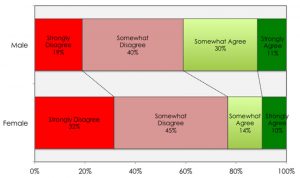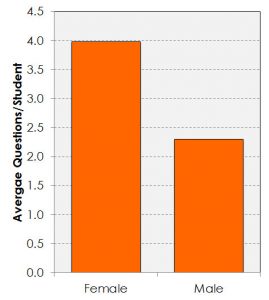Opening day! First class of the year! For many of us this is a time to redesign our lectures with an eye to improving how we present our material. But lost in our efforts to develop the clearest explanations and illustrations is the reality that a large percent of the students in our classes are going to be reluctant to interact with us regardless how gifted the presentation.
Last year on opening day I asked my students in a survey:
“When I have questions in a large lecture, I am comfortable asking them verbally during class.”

Figure 1. Answers to question “When I have questions in class, I am comfortable asking them verbally” presented on first day of class.
and discovered (Figure 1) that only about 40% of the male students and fewer 25% of female students answered either “Somewhat Agree”or “Strongly Agree.” This is striking for two reasons. First, it implies that a minority of students will feel comfortable stopping class to ask a question. Second, it implies that teaching my course as a traditional lecture course creates an uneven playing field with female students less likely to participate equally in student inquiry.
In class I use Echo360’s Active Learning Platform that allows students to pose questions digitally during class on any mobile device. Student pose questions during class and either my teaching assistant answers these questions during class in a side channel or I answer them after class. Students see all the questions and answers but do not see who asked the question (but I do see who asked each question). Last semester in that same class this resulted in two remarkable changes.
- First we had 413 questions submitted over the semester. Now I’ve been teaching for over 36 years and in previous years when I asked verbally “Any questions?” I would rarely hear a sound. This is sobering as it implies I was probably confusing for the previous 35 years and didn’t appreciate how much.
- Second, and arguably more important, the number of questions posed per capita by female students was almost twice the rate as male students (Figure 2).
Victory! The playing field has been leveled. Now all students can more comfortably participate in class when they have questions.
I imagine some will want to argue that students need to learn to speak up verbally in class. But many students arriving at college don’t feel confident about their abilities yet and are fearful of looking dumb in a large class. Some are first-generation students coming from smaller schools and are intimidated by the new environment. I argue that having the ability to pose questions gives all students the opportunity to see that their questions are no less ‘dumb’ as anyone else’s.
So, as you worry about the design of your course take a moment to consider how you can make it comfortable for ALL students to participate. A means to allow anonymous inquiry is a step in that direction. It should not replace verbal discussion but, I argue, is a healthy alternative for those less comfortable which I suspect includes a number of populations like those for whom English is not their first language as well as the gender differences I’m seeing in my science class.

